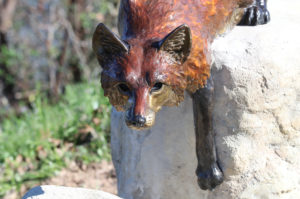Stalking Fox
“Stalking Fox” was cast in silicon bronze in the artist’s personal foundry, which he has operated with his father since 1983. Silicon bronze has a higher copper content and a more copper color than regular bronze, which works really well for the underlying color of this fox. Notice the color variation, which is due to the application of a special patina that defines the features and helps protect the bronze. Notice how alert and stealthy this animal looks. This artist often chooses to put the animals he creates in action poses. What do you think that tells us about the animal? In European and East Asian folklore, foxes are often a symbol for cleverness, stealth, or trickery. Do you know what it means to “outfox” someone?

By David Turner
The artist, David Turner, has been a professional sculptor for 35 years, during which he has made over 60 large public commission sculptures at zoos, museums, aquariums, universities, and municipalities throughout the United States. David works from his own foundry with his father, Bill Turner, on the Eastern Shore of Virginia. They are inspired by the wildlife of the Chesapeake Bay. They have over 100 public sculptures in many famous places and one of their sculptures was owned by former President George H.W. Bush.
View all sculptures by this artist.Did You Know?
- Foxes are very fast and can run up to 45 miles per hour.
- Foxes like to stick to their family members, and a pack may include siblings, mates, and their mothers.
- Foxes are omnivores, which means they eat both meat and vegetation.
- If they have trouble finding food, a fox has no problem raiding a trash can.
- Foxes can eat up to several pounds of food a day. What they don’t eat, they will often store under leaves or snow to save for later.
- Foxes are usually monogamous, which means they often have only one mate for life.
- There is a family of wild foxes that have made Cameron Park Zoo their home. They love to catch insects under the lights of the parking lot after visitors have headed home.
Location



